| Petra | |
|---|---|

Al Khazneh or The Treasury at Petra
| |
| Location | Ma'an Governorate, Jordan |
| Coordinates | 30°19′43″N 35°26′31″ECoordinates: 30°19′43″N 35°26′31″E |
| Elevation | 810 m (2,657 ft) |
| Built | possibly as early as 309 BC[citation needed] |
| Visitation | 580,000 (in 2007) |
| Governing body | Petra Region Authority |
| Type | Cultural |
| Criteria | i, iii, iv |
| Designated | 1985 (9th session) |
| Reference No. | 326 |
| State Party | Jordan |
| Region | Arab States |
| Website | www.visitpetra.jo |
Petra (Arabic: البتراء, Al-Batrāʾ, Ancient Greek Πέτρα) is a historical and archaeological city in the southern Jordanian governorate of Ma'an, that is famous for its rock-cut architecture and water conduit system. Another name for Petra is the Rose City due to the color of the stone out of which it is carved.
Established possibly as early as 312 BCE as the capital city of the Nabataeans,[1] it is a symbol of Jordan, as well as its most-visited tourist attraction.[2] It lies on the slope of Jebel al-Madhbah (identified by some as the biblical Mount Hor[3]) in a basin among the mountains which form the eastern flank of Arabah (Wadi Araba), the large valley running from the Dead Sea to the Gulf of Aqaba. Petra has been a UNESCO World Heritage Site since 1985.
The site remained unknown to the Western world until 1812, when it was introduced by Swiss explorer Johann Ludwig Burckhardt. It was described as "a rose-red city half as old as time" in a Newdigate Prize-winning poem by John William Burgon. UNESCO has described it as "one of the most precious cultural properties of man's cultural heritage".[4] See: UNESCO Intangible Cultural Heritage Lists. Petra was chosen by the Smithsonian Magazine as one of the "28 Places to See Before You Die."[5]
Contents
[hide]Geography[edit]
Pliny the Elder and other writers identify Petra as the capital of the Nabataeans and the center of their caravan trade. Enclosed by towering rocks and watered by a perennial stream, Petra not only possessed the advantages of a fortress, but controlled the main commercial routes which passed through it to Gaza in the west, to Bosra and Damascus in the north, to Aqaba and Leuce Come on the Red Sea, and across the desert to the Persian Gulf.
Excavations have demonstrated that it was the ability of the Nabataeans to control the water supply that led to the rise of the desert city, creating an artificial oasis. The area is visited by flash floods and archaeological evidence demonstrates the Nabataeans controlled these floods by the use of dams, cisterns and water conduits. These innovations stored water for prolonged periods of drought, and enabled the city to prosper from its sale.[6][7]
Although in ancient times Petra might have been approached from the south on a track leading across the plain of Petra, around Jabal Haroun ("Aaron's Mountain"), where theTomb of Aaron, said to be the burial-place of Aaron brother of Moses is located, or possibly from the high plateau to the north, most modern visitors approach the site from the east. The impressive eastern entrance leads steeply down through a dark, narrow gorge (in places only 3–4 m (9.8–13 ft) wide) called the Siq ("the shaft"), a natural geological feature formed from a deep split in the sandstone rocks and serving as a waterway flowing into Wadi Musa. At the end of the narrow gorge stands Petra's most elaborate ruin, Al Khazneh (popularly known as "the Treasury"), hewn into the sandstone cliff. While remaining in remarkably preserved condition, the face of the structure is marked by hundreds of bullet holes made by the local Bedouin tribes that hoped to dislodge riches that were once rumored to be hidden within it.[8]
A little farther from the Treasury, at the foot of the mountain called en-Nejr, is a massive theatre, so placed as to bring the greatest number oftombs within view. At the point where the valley opens out into the plain, the site of the city is revealed with striking effect. The amphitheatre has been cut into the hillside and into several of the tombs during its construction. Rectangular gaps in the seating are still visible. Almost enclosing it on three sides are rose-coloured mountain walls, divided into groups by deep fissures, and lined with knobs cut from the rock in the form of towers.
History[edit]
Evidence suggests that settlements had begun in and around Petra in the eighteenth dynasty of Egypt (1550–1292 BCE)[citation needed]. It is listed in Egyptian campaign accounts and the Amarna letters as Pel, Sela or Seir. Though the city was founded relatively late, a sanctuary existed there since very ancient times. Stations 19 through 26 of the stations list of Exodus are places associated with Petra.[9] This part of the country was biblically assigned to the Horites, the predecessors of the Edomites.[10] The habits of the original natives may have influenced the Nabataean custom of burying the dead and offering worship in half-excavated caves. Although Petra is usually identified with Sela which means a rock, the Biblical references[11] refer to it as "the cleft in the rock", referring to its entrance. The second book of Kings xiv. 7 seems to be more specific. In the parallel passage, however, Sela is understood to mean simply "the rock" (2Chronicles xxv. 12, see LXX).
On the authority of Josephus (Antiquities of the Jews iv. 7, 1~ 4, 7) Eusebius and Jerome (Onom. sacr. 286, 71. 145, 9; 228, 55. 287, 94) assert that Rekemwas the native name and this name appears in the Dead Sea Scrolls[12] as a prominent Edom site most closely describing Petra and associated with Mount Seir. But in the Aramaic versions Rekem is the name of Kadesh, implying that Josephus may have confused the two places. Sometimes the Aramaic versions give the form Rekem-Geya which recalls the name of the village El-ji, southeast of Petra.[citation needed] The Semitic name of the city, if not Sela, remains unknown. The passage in Diodorus Siculus (xix. 94–97) which describes the expeditions which Antigonus sent against the Nabataeans in 312 BCE is understood to throw some light upon the history of Petra, but the "petra" referred to as a natural fortress and place of refuge cannot be a proper name and the description implies that the town was not yet in existence.
The name "Rekem" was inscribed in the rock wall of the Wadi Musa opposite the entrance to the Siq,[13] but about twenty years ago[timeframe?] the Jordanians built a bridge over the wadi and this inscription was buried beneath tons of concrete.[citation needed]
More satisfactory evidence of the date of the earliest Nabataean settlement may be obtained from an examination of the tombs. Two types of tombs have been distinguished: the Nabataean and the Greco-Roman. The Nabataean type starts from the simple pylon-tomb with a door set in a tower crowned by a parapet ornament, in imitation of the front of a dwelling-house. Then, after passing through various stages, the full Nabataean type is reached, retaining all the native features and at the same time exhibiting characteristics which are partly Egyptian and partly Greek. Of this type close parallels exist in the tomb-towers at Mada'in Saleh in north Arabia, which bear long Nabataean inscriptions and supply a date for the corresponding monuments at Petra. Then comes a series of tombfronts which terminate in a semicircular arch, a feature derived from north Syria. Finally come the elaborate façades copied from the front of a Roman temple; however, all traces of native style have vanished. The exact dates of the stages in this development cannot be fixed. Few inscriptions of any length have been found at Petra, perhaps because they have perished with the stucco or cement which was used upon many of the buildings. The simple pylon-tombs which belong to the pre-Hellenic age serve as evidence for the earliest period. It is not known how far back in this stage the Nabataean settlement goes, but it does not go back farther than the 6th century BCE.
A period follows in which the dominant civilization combines Greek, Egyptian and Syrian elements, clearly pointing to the age of the Ptolemies. Towards the close of the 2nd century BCE, when the Ptolemaic and Seleucid kingdoms were equally depressed, the Nabataean kingdom came to the front. Under Aretas III Philhellene, (c.85–60 BCE), the royal coins begin. The theatre was probably excavated at that time, and Petra must have assumed the aspect of a Hellenistic city. In the reign of Aretas IV Philopatris, (9 BCE–40 CE), the tombs of the el-I~ejr[clarification needed] type may be dated, and perhaps also the High-place.
Roman rule[edit]
In 106 CE, when Cornelius Palma was governor of Syria, that part of Arabia under the rule of Petra was absorbed into the Roman Empire as part ofArabia Petraea, and became its capital. The native dynasty came to an end, but the city continued to flourish. It was around this time that the Petra Roman Road was built. A century later, in the time of Alexander Severus, when the city was at the height of its splendor, the issue of coinage comes to an end. There is no more building of sumptuous tombs, owing apparently to some sudden catastrophe, such as an invasion by the neo-Persian power under theSassanid Empire. Meanwhile, as Palmyra (fl. 130–270) grew in importance and attracted the Arabian trade away from Petra, the latter declined. It seems, however, to have lingered on as a religious centre. A Roman road was constructed at the site. Epiphanius of Salamis (c.315–403) writes that in his time a feast was held there on December 25 in honor of the virgin Khaabou (Chaabou) and her offspring Dushara (Haer. 51).[citation needed]
Byzantine era - decline[edit]
Petra declined rapidly under Roman rule, in large part from the revision of sea-based trade routes. In 363 an earthquake destroyed many buildings, and crippled the vital water management system.[14] The last inhabitants abandoned the city (further weakened by another major earthquake in 551) when the Arabs conquered the region in 663. The ruins of Petra were an object of curiosity in the Middle Ages and were visited by Sultan Baibars of Egypt towards the end of the 13th century. The first European to describe them was Swiss traveller Johann Ludwig Burckhardt in 1812.
Because the structures weakened with age, many of the tombs became vulnerable to thieves, and many treasures were stolen. In 1929, a four-person team, consisting of British archaeologists Agnes Conway and George Horsfield, Palestinian physician and folklore expert Dr Tawfiq Canaan and Dr Ditlef Nielsen, a Danish scholar, excavated and surveyed Petra.[15]
T. E. Lawrence (Lawrence of Arabia)[edit]
In October 1917, as part of a general effort to divert Ottoman military resources away from the British advance before the Third Battle of Gaza, a revolt of Syrians and Arabians in Petra was led by British Army officer T. E. Lawrence against the Ottoman regime. The Bedouin women living in the vicinity of Petra and under the leadership of Sheik Khallil's wife were gathered to fight in the revolt of the city. The rebellions, with the support of English military, were able to devastate the Ottoman forces.[16]
Religion[edit]
See also: Nabataean art
The Nabataeans worshipped the Arab gods and goddesses of the pre-Islamic times as well as a few of their deified kings. One, Obodas I, was deified after his death. Dushara was the main male god accompanied by his female trinity: Al-‘Uzzá, Allat and Manāt. Many statues carved in the rock depict these gods and goddesses.
A stele is dedicated to Qos-Allah 'Qos is Allah' or 'Qos the god', by Qosmilk (melech - king) is found at Petra (Glueck 516). Qos is identifiable with Kaush (Qaush) the God of the older Edomites. The stele is horned and the seal from the Edomite Tawilan near Petra identified with Kaush displays a star and crescent (Browning 28), both consistent with a moon deity. It is conceivable the latter could have resulted from trade with Harran (Bartlett 194). There is continuing debate about the nature of Qos (qaus - bow) who has been identified both with a hunting bow (hunting god) and a rainbow (weather god) although the crescent above is also a bow.
Nabatean inscriptions in Sinai and other places display widespread references to names including Allah, El and Allat (god and goddess), with regional references to al-Uzza, Baal and Manutu (Manat) (Negev 11). Allat is also found in Sinai in South Arabian language. Allah occurs particularly as Garm-'allahi - god dedided (Greek Garamelos) and Aush-allahi - 'gods covenant' (Greek Ausallos). We find both Shalm-lahi 'Allah is peace' and Shalm-allat, 'the peace of the goddess'. We also find Amat-allahi 'she-servant of god' and Halaf-llahi 'the successor of Allah'.[17]
The Monastery, Petra's largest monument, dates from the 1st century BCE. It was dedicated to Obodas I and is believed to be the symposium of Obodas the god. This information is inscribed on the ruins of the Monastery (the name is the translation of the Arabic "Ad Deir").
Christianity found its way to Petra in the 4th century CE, nearly 500 years after the establishment of Petra as a trade center. Athanasius mentions a bishop of Petra (Anhioch. 10) named Asterius. At least one of the tombs (the "tomb with the urn"?) was used as a church. An inscription in red paint records its consecration "in the time of the most holy bishop Jason" (447). After the Islamic conquest of 629–632 Christianity in Petra, as of most of Arabia, gave way to Islam. During the First Crusade Petra was occupied by Baldwin I of the Kingdom of Jerusalem and formed the second fief of the barony of Al Karak (in the lordship of Oultrejordain) with the title Château de la Valée de Moyse or Sela. It remained in the hands of theFranks until 1189. It is still a titular see of the Catholic Church.[18]
Two Crusader-period castles are known in and around Petra. The first is al-Wu'ayra and is situated just north of Wadi Musa. It can be viewed from the road to "Little Petra". It is the castle of Valle Moise which was seized by a band of Turks with the help of local Muslims and only recovered by the Crusaders after they began to destroy the olive trees of Wadi Musa. The potential loss of livelihood led the locals to negotiate surrender. The second is on the summit of el-Habis in the heart of Petra and can be accessed from the West side of the Qasr al-Bint.
According to Arab tradition, Petra is the spot where Moses (Musa) struck a rock with his staff and water came forth, and where Moses' brother, Aaron (Harun), is buried, at Mount Hor, known today as Jabal Haroun or Mount Aaron. The Wadi Musa or "Wadi of Moses" is the Arab name for the narrow valley at the head of which Petra is sited. A mountaintop shrine of Moses' sisterMiriam was still shown to pilgrims at the time of Jerome in the 4th century, but its location has not been identified since.[19]
Threats to Petra[edit]
The site suffers from a host of threats, including collapse of ancient structures, erosion due to flooding and improper rainwater drainage, weathering from salt upwelling, improper restoration of ancient structures, and unsustainable tourism.[20] The latter has increased substantially, especially since the site received widespread media coverage in 2007 during the controversial New Seven Wonders of the World Internet and cell phone campaign.[21]
In an attempt to reduce the impact of these threats, Petra National Trust (PNT) was established in 1989. Over this time, it has worked together with numerous local and international organizations on projects that promote the protection, conservation and preservation of the Petra site.[22] Moreover, UNESCO and ICOMOS recently collaborated to publish their first book on human and natural threats to these sensitive World Heritage sites. They chose Petra as its first, and most important example of threatened landscapes. A book released in 2012, Tourism and Archaeological Heritage Management at Petra: Driver to Development or Destruction?, represents the first in a series of important books to address the very nature of these deteriorating buildings, cities, sites, and regions. The next books in the series of deteriorating UNESCO World Heritage Sites will include Macchu Picchu, Angkor Wat, and Pompeii. (25).
Petra today[edit]
On December 6, 1985, Petra was designated a World Heritage Site.
In popular culture[edit]
Petra was the main topic in John William Burgon's Poem Petra. Referring to it as the inaccessible city which he had heard described but had never seen. The Poem was awarded the Newdigate Prize in 1845:
It seems no work of Man's creative hand,by labour wrought as wavering fancy planned;
- But from the rock as if by magic grown,
eternal, silent, beautiful, alone!
- Not virgin-white like that old Doric shrine,
where erst Athena held her rites divine;
- Not saintly-grey, like many a minster fane,
that crowns the hill and consecrates the plain;
- But rose-red as if the blush of dawn,
that first beheld them were not yet withdrawn;
- The hues of youth upon a brow of woe,
which Man deemed old two thousand years ago,
- match me such marvel save in Eastern clime,
a rose-red city half as old as time.
In 1977, the Lebanese Rahbani brothers wrote the musical "Petra" as a response to the Lebanese Civil War.[23]
The site is featured in films such as: Indiana Jones and the Last Crusade, Arabian Nights, Passion in the Desert, Mortal Kombat: Annihilation, Sinbad and the Eye of the Tiger, and Transformers: Revenge of the Fallen.
It was recreated for the video games Spy Hunter (2001), King's Quest V, Lego Indiana Jones, Sonic Unleashed and Civilization V.
Petra appeared in the novels Left Behind Series, Appointment with Death, The Eagle in the Sand, The Red Sea Sharks, the nineteenth book in The Adventures of Tintin series and in Kingsbury'sThe Moon Goddess and the Son. It featured prominently in the Marcus Didius Falco mystery novel Last Act in Palmyra. In Blue Balliett's novel, Chasing Vermeer, the character Petra Andalee is named after the site.[24]
The Sisters of Mercy filmed their music video for "Dominion/Mother Russia" in and around Al Khazneh ("The Treasury") in February 1988.
In 1994 Petra featured in the video to the Urban Species video Spiritual Love.
Petra was featured in episode 3 of the 2010 series An Idiot Abroad.
In 1979 Marguerite van Geldermalsen from New Zealand married Mohammed Abdullah, a Bedouin in Petra.[25] They lived in a cave in Petra until the death of her husband. She authored the bookMarried to a Bedouin. Geldermalsen is the only western woman who has ever lived in Petra.
Sister cities[edit]
 Plovdiv, Bulgaria
Plovdiv, Bulgaria Mada'in Saleh in Saudi Arabia is the second largest and southernmost of this civilization's settlements
Mada'in Saleh in Saudi Arabia is the second largest and southernmost of this civilization's settlements



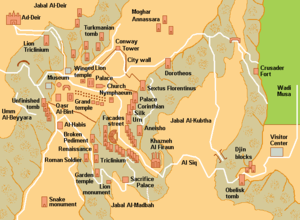

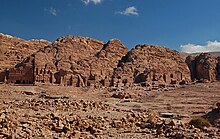
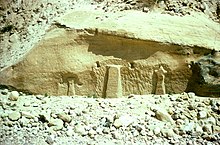

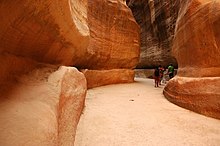

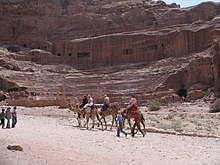
Nenhum comentário:
Postar um comentário